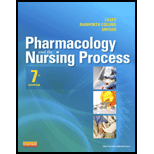
(1)
To determine:
The medication preferred by you to give to Mr. J, complaining about a headache. Explain your answer.
Case summary:
Mr. J. was a 68-year-old farmer was hospitalized for a week due to the exacerbation of chronic emphysema. This was aggravated by the fall harvesting dust. He had type 2 diabetes mellitus. He quitted smoking 4 years ago and maintains a proper diet. He did not have any drug allergies previously. Through the nasal cannula, he received oxygen at 1 L/min. On following the medications and therapies, his breathing became easier, hence, he may go home soon.
(2)
To determine:
What would be the contribution for the elevated glucose level on considering Mr. J.’s medications and what laboratory values that are needed to be monitored?
Case summary:
Mr. J. was a 68-year-old farmer was hospitalized for a week due to the exacerbation of chronic emphysema. This was aggravated by the fall harvesting dust. He had type 2 diabetes mellitus. He quitted smoking 4 years ago and maintains a proper diet. He did not have any drug allergies previously. Through the nasal cannula, he received oxygen at 1 L/min. On following the medications and therapies, his breathing became easier, hence, he may go home soon.
(3)
To determine:
What do you expect that happened to cause the symptoms of Mr. J.
Case summary:
Mr. J. was a 68-year-old farmer was hospitalized for a week due to the exacerbation of chronic emphysema. This was aggravated by the fall harvesting dust. He had type 2 diabetes mellitus. He quitted smoking 4 years ago and maintains a proper diet. He did not have any drug allergies previously. Through the nasal cannula, he received oxygen at 1 L/min. On following the medications and therapies, his breathing became easier, hence, he may go home soon.
(4)
To determine:
What appropriate nursing diagnoses should be done for Mr. J.
Case summary:
Mr. J. was a 68-year-old farmer was hospitalized for a week due to the exacerbation of chronic emphysema. This was aggravated by the fall harvesting dust. He had type 2 diabetes mellitus. He quitted smoking 4 years ago and maintains a proper diet. He did not have any drug allergies previously. Through the nasal cannula, he received oxygen at 1 L/min. On following the medications and therapies, his breathing became easier, hence, he may go home soon.
Want to see the full answer?
Check out a sample textbook solution
Chapter 33 Solutions
Pharmacology and the Nursing Process
- Discuss Hypertension under the following headings: Definition Diagnosis Non-pharmacological intervention Drugs Classification Management of a Hypertensive emergencyarrow_forwardExplain how the answer could be 2 or 1.8 WITHOUT changing the questionarrow_forwardoverview of the neurological system, cranial nerves and what part of the body it innervatesarrow_forward
- differentiate structure and function of the peripheral vascular system. what are the normal and abnormal findings of the peripheral arterioles and peripheral venous systemarrow_forwardAn overview of the skin, hair and nails epidermal appendages normal and abnormal findingsarrow_forwarddifferentiate the twelve cranial nerves and how to test themarrow_forward
- What are the nursing interventions for patients with GI problems ? What is the priority ?arrow_forwardAdult Nutrition Assessment Date of consultation: 3/2/25 Reason for Nutrition Assessment: Mrs. Clover was referred to the RD from the ER physician; patient experiencing weight loss, SOB & Edema Nutrition Assessment Data 69 YOF Ht 157 cm, Wt 53 kg. BMI 21.7 Usual wt 55 kg Heart: slight physiologic murmur; lungs: clear; extremities: 3+ edema to bilateral lower legs; elevated BP, abdomen: soft, nontender, active bowel sounds; neurologic: unremarkable; skin: diminished skin tugor. Biochemical Data BUN 72, Creatinine 4.6, Calcium 7.2, Phosphorus 7.3, glucose 105, BNP 720, Albumin 2.0, Na 125, K 3.3, CI 93. Hgb 11.5, Hct 33.2, ALT 29, AST 36, Alkaline phosphatase 120, other relevant labs pending result. Medications Include inhalers, Cymbalta, Neurontin, Seroquel, and topiramate, prilosec, solumedrol, rocephin, zithromax, NaCl 0.45%+50 MEQ sodium bicarbonate @100 ml/hr. No history of herbal supplements. Since her pneumonia diagnosis several days ago, she has felt too weak to prepare meals, she…arrow_forwardAssuming you are a community health nurse, choose a community of your own and perform practically the following and report your findings: a. Community Assessment b. Community Diagnosisarrow_forward
- Describe practically how you would use a standing order in the diagnosis and treatment of a 10-year-old primary school pupil with a complaint of haematuria at the end of the urine.arrow_forwardSimple explanations, please. B. Why is an accurate diagnosis of malnutrition important? H. Is BMI a food indicator of malnutrition? I. Can an overweight/obese patient develop malnutrition? Why or why not?arrow_forwardHow is the severity of malnutrition determined based off the table? Simple explanation please.arrow_forward
 Phlebotomy EssentialsNursingISBN:9781451194524Author:Ruth McCall, Cathee M. Tankersley MT(ASCP)Publisher:JONES+BARTLETT PUBLISHERS, INC.
Phlebotomy EssentialsNursingISBN:9781451194524Author:Ruth McCall, Cathee M. Tankersley MT(ASCP)Publisher:JONES+BARTLETT PUBLISHERS, INC. Gould's Pathophysiology for the Health Profession...NursingISBN:9780323414425Author:Robert J Hubert BSPublisher:Saunders
Gould's Pathophysiology for the Health Profession...NursingISBN:9780323414425Author:Robert J Hubert BSPublisher:Saunders Fundamentals Of NursingNursingISBN:9781496362179Author:Taylor, Carol (carol R.), LYNN, Pamela (pamela Barbara), Bartlett, Jennifer L.Publisher:Wolters Kluwer,
Fundamentals Of NursingNursingISBN:9781496362179Author:Taylor, Carol (carol R.), LYNN, Pamela (pamela Barbara), Bartlett, Jennifer L.Publisher:Wolters Kluwer, Fundamentals of Nursing, 9eNursingISBN:9780323327404Author:Patricia A. Potter RN MSN PhD FAAN, Anne Griffin Perry RN EdD FAAN, Patricia Stockert RN BSN MS PhD, Amy Hall RN BSN MS PhD CNEPublisher:Elsevier Science
Fundamentals of Nursing, 9eNursingISBN:9780323327404Author:Patricia A. Potter RN MSN PhD FAAN, Anne Griffin Perry RN EdD FAAN, Patricia Stockert RN BSN MS PhD, Amy Hall RN BSN MS PhD CNEPublisher:Elsevier Science Study Guide for Gould's Pathophysiology for the H...NursingISBN:9780323414142Author:Hubert BS, Robert J; VanMeter PhD, Karin C.Publisher:Saunders
Study Guide for Gould's Pathophysiology for the H...NursingISBN:9780323414142Author:Hubert BS, Robert J; VanMeter PhD, Karin C.Publisher:Saunders Issues and Ethics in the Helping Professions (Min...NursingISBN:9781337406291Author:Gerald Corey, Marianne Schneider Corey, Cindy CoreyPublisher:Cengage Learning
Issues and Ethics in the Helping Professions (Min...NursingISBN:9781337406291Author:Gerald Corey, Marianne Schneider Corey, Cindy CoreyPublisher:Cengage Learning





